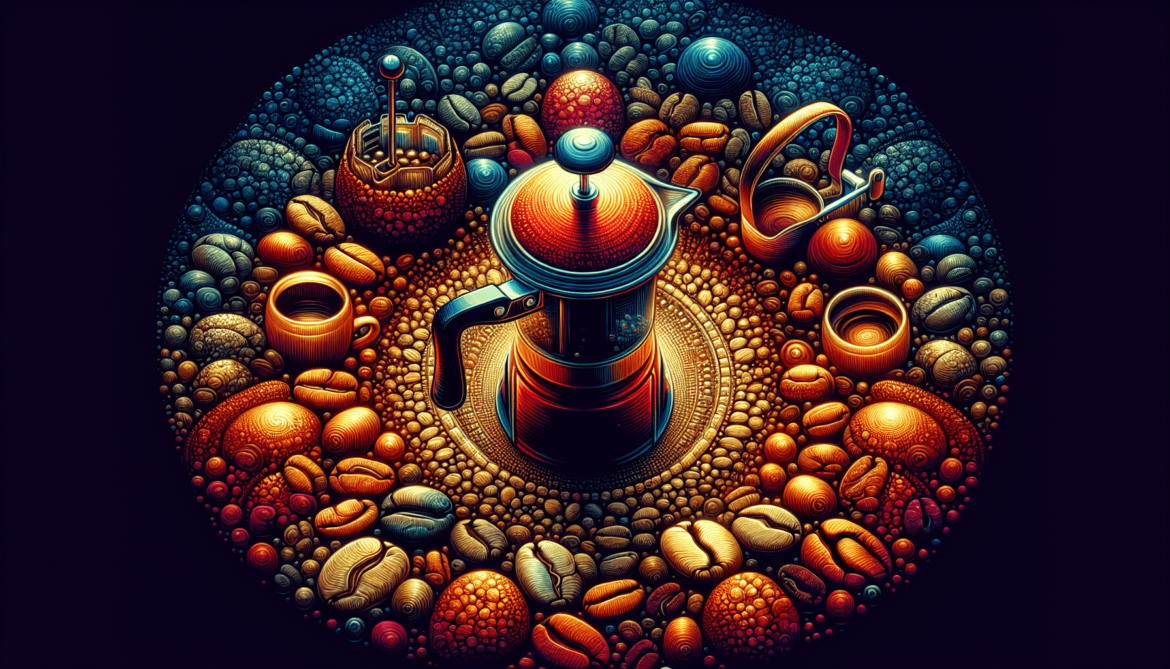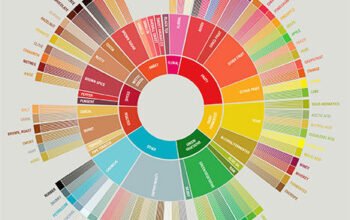Are you a coffee lover who is eager to explore different brewing methods? Look no further, as this article will take you on a journey through the world of coffee brewing. From the classic French Press to the beloved Espresso machine, we will explore the unique characteristics and brewing techniques that make each method a favorite among coffee enthusiasts. Whether you prefer a rich and robust cup of coffee or a strong and concentrated shot of espresso, we have got you covered. So grab your favorite coffee beans and get ready to discover the art of brewing.
French Press
What is a French Press?
A French Press, also known as a press pot or plunger pot, is a popular brewing device used to make coffee. It consists of a cylindrical glass or stainless steel container with a plunger and a mesh filter. The French Press is loved by coffee enthusiasts for its simplicity and ability to produce a full-bodied and flavorful cup of coffee.
How does it work?
Using a French Press is a straightforward process. First, you add coarsely ground coffee into the container. Then, you pour hot water over the coffee grounds, ensuring that all the grounds are saturated. After allowing the coffee to steep for a few minutes, you press the plunger down slowly, separating the brewed coffee from the grounds. The mesh filter prevents any sediment or coffee grounds from reaching your cup, resulting in a clean brew.
Advantages of using a French Press
There are several advantages to using a French Press to brew your coffee. Firstly, it allows for complete control over the brewing process, as you can adjust the water temperature, steeping time, and coffee-to-water ratio to your preference. Additionally, the French Press preserves the natural oils and flavors of the coffee beans, resulting in a rich and aromatic cup of coffee. It is also a portable brewing method, making it ideal for camping trips or traveling.
Disadvantages of using a French Press
While the French Press offers many advantages, it also has a few drawbacks to consider. One disadvantage is that the coffee produced can be quite strong and may contain some sediment due to the mesh filter not being fine enough to filter out all the coffee grounds. Additionally, the brewing time can be longer compared to other methods, as the coffee needs to steep for a few minutes. Cleaning the French Press can also be a bit more involved, as you need to disassemble and clean the various parts.
Pour Over
What is a Pour Over?
A Pour Over is a manual brewing method that involves pouring water over coffee grounds to extract the flavors and aromas. It typically consists of a cone-shaped dripper, such as a V60 or a Chemex, and a paper or metal filter. Pour Over brewing has gained popularity in recent years due to its ability to produce a clean and nuanced cup of coffee.
How does it work?
To use a Pour Over, you first place a paper or metal filter in the dripper and rinse it with hot water to remove any paper taste and preheat the brewing vessel. Next, you add medium-coarse coffee grounds into the filter. As you pour hot water evenly over the coffee, it slowly drips into your cup below. The water-to-coffee ratio, pouring technique, and brew time can be adjusted to achieve your desired flavor and strength.
Advantages of using a Pour Over
Pour Over brewing offers several advantages. One of the main benefits is the level of control it provides over the brewing process. You can control the flow rate and water distribution, resulting in a more consistent and flavorful cup. It also allows you to highlight specific flavor notes and nuances of different coffee beans. The simplicity of the method and the minimal equipment required make it accessible and easy to use.
Disadvantages of using a Pour Over
Despite its popularity, Pour Over brewing has a few disadvantages to consider. The process requires more time and attention compared to other brewing methods, as you need to pour the water slowly and consistently. It may take some practice to master the pouring technique and achieve a balanced cup of coffee. Additionally, the paper filters used in Pour Over brewing can absorb some of the coffee’s oils and flavors, resulting in a cleaner but potentially less rich brew.
Chemex
What is a Chemex?
A Chemex is a pour-over brewing device that stands out with its elegant design. It is made of high-quality borosilicate glass and features an hourglass shape with a wooden collar and leather tie. The Chemex not only produces a great cup of coffee but also serves as a stylish centerpiece on your dining table or kitchen countertop.
How does it work?
Using a Chemex is similar to other pour-over methods. You place a Chemex-bonded paper filter in the upper chamber and rinse it with hot water. Then, you add medium-coarse coffee grounds and slowly pour hot water in a circular motion over the grounds. The water passes through the filter, extracting the flavors and oils, and drips down into the lower chamber. The Chemex’s unique shape and thick filter paper contribute to the coffee’s exceptional clarity and purity.
Advantages of using a Chemex
One of the key advantages of using a Chemex is the clarity and cleanliness of the resulting cup of coffee. The thick bonded paper filters remove most of the sediment, oils, and bitterness, producing a smooth and flavorful brew. The Chemex’s design also allows for precise pouring, ensuring an even extraction and optimal coffee flavor. Additionally, the Chemex’s aesthetic appeal and the ability to brew larger quantities make it a popular choice for entertaining or serving multiple people.
Disadvantages of using a Chemex
While the Chemex produces superb coffee, it does have a few disadvantages to consider. The filters used in the Chemex can be more expensive compared to other brewing methods. The thick filters can also slow down the brewing process, resulting in a longer brew time than other pour-over methods. Additionally, the delicate glass construction of the Chemex requires careful handling and can be prone to breaking if mishandled.
AeroPress
What is an AeroPress?
The AeroPress is a versatile and portable coffee brewing device that has gained a loyal following since its introduction in 2005. It is a compact cylindrical device with a plunger, a chamber, and a filter cap. The AeroPress is known for its ability to produce a clean and flavorful cup of coffee, making it a favorite among coffee enthusiasts and adventurers alike.
How does it work?
Using an AeroPress involves a simple yet unique brewing process. First, a paper or metal filter is placed inside the filter cap and rinsed with hot water. The coffee grounds and water are then combined in the chamber, and the plunger is inserted to create a seal. After a brief steeping period, the plunger is pressed down, forcing the brewed coffee through the filter and into your cup. The result is a smooth and concentrated coffee that can be diluted with water if desired.
Advantages of using an AeroPress
The AeroPress offers several advantages that make it a popular choice among coffee lovers. One of the main benefits is its versatility and portability. The lightweight and compact design make it easy to take on camping trips or when traveling. The AeroPress is also forgiving and easy to use, producing consistent and flavorful coffee without requiring advanced brewing techniques. It is also known for its quick brewing time, allowing you to enjoy a great cup of coffee in minutes.
Disadvantages of using an AeroPress
Despite its popularity, the AeroPress does have a few drawbacks. It is designed to brew individual cups of coffee, so it may not be suitable for large gatherings. The resulting cup can be on the smaller side, requiring multiple brews if you prefer larger servings. While the AeroPress produces a clean brew, it may lack some of the body and depth found in other brewing methods. Additionally, the paper filters used in the AeroPress can absorb some of the coffee oils, potentially reducing the overall intensity of the flavors.
Siphon
What is a Siphon?
The Siphon, also known as a vacuum coffee maker, is a visually impressive brewing method that dates back to the 19th century. It consists of two chambers, a lower one that holds water and an upper one for the coffee grounds. The Siphon uses vapor pressure and gravity to create a unique and flavorful cup of coffee.
How does it work?
Using a Siphon requires a bit more technique and precision compared to other brewing methods. First, you add water to the lower chamber and heat it, causing pressure to build. As the pressure increases, the water is forced up into the upper chamber, where the coffee grounds are added. After stirring the grounds, you remove the heat source, allowing the brewed coffee to flow back down to the lower chamber as the pressure equalizes. The result is a smooth and aromatic cup of coffee.
Advantages of using a Siphon
The Siphon brewing method offers several advantages that set it apart. The brewing process is highly visual and can be quite captivating to watch, making it a fantastic centerpiece for coffee brewing demonstrations or social gatherings. The Siphon’s unique extraction method also produces a clean and full-bodied coffee with enhanced flavors and aromas. It allows for precise control over variables such as water temperature and brewing time, resulting in a customizable brewing experience.
Disadvantages of using a Siphon
While the Siphon brewing method has its charm, there are a few disadvantages to keep in mind. The setup and brewing process can be more complicated and time-consuming compared to other methods, requiring additional equipment and attention to detail. The glass chambers used in the Siphon are delicate and can be prone to breaking if mishandled. Additionally, the Siphon may not be as accessible for casual coffee drinkers or those who prefer a quicker brewing process.
Cold Brew
What is Cold Brew?
Cold Brew is a coffee brewing method that involves steeping coffee grounds in cold or room temperature water for an extended period. Unlike other brewing methods, Cold Brew does not involve hot water and instead relies on time to extract the coffee’s flavors and compounds. The result is a smooth, low-acid, and highly concentrated coffee concentrate that can be enjoyed over ice or diluted with water.
How does it work?
Cold Brew is a simple and straightforward brewing method. Coarsely ground coffee is combined with cold or room temperature water in a container. The mixture is then stirred to ensure thorough saturation of the grounds. The container is then covered or sealed and left to steep for an extended period, usually overnight or up to 24 hours. After steeping, the brewed coffee is separated from the grounds using a filter or a cheesecloth, resulting in a smooth and flavorful concentrate.
Advantages of using Cold Brew
Cold Brew offers several advantages that have contributed to its growing popularity. One of the main advantages is its low acidity compared to hot brewed coffee. The extended steeping time in cold water results in a coffee concentrate that is less acidic and smoother on the palate. Cold Brew is also highly versatile and can be enjoyed on its own, diluted with water, or incorporated into various coffee-based beverages. It is also an ideal brewing method for hot summer days as it produces a refreshing and chilled coffee.
Disadvantages of using Cold Brew
While Cold Brew has its merits, it also has a few drawbacks to consider. Due to the extended steeping time, Cold Brew requires advanced planning and cannot be made on-demand like other brewing methods. The concentration of the brewed coffee may also be too strong for some drinkers, requiring dilution or additional ingredients to achieve the desired flavor. Additionally, Cold Brew typically requires a larger amount of coffee grounds compared to other methods, making it less cost-effective if you consume coffee in large quantities.
Moka Pot
What is a Moka Pot?
A Moka Pot, also known as a stovetop espresso maker, is a brewing device that originated in Italy. It is designed to produce a strong and concentrated coffee that resembles espresso, although it is not technically espresso. The Moka Pot consists of a bottom chamber for water, a middle chamber for coffee grounds, and a top chamber for the final brewed coffee.
How does it work?
Using a Moka Pot involves a unique brewing process that relies on steam pressure and heat. First, water is added to the bottom chamber, and coffee grounds are placed in the middle chamber. As the Moka Pot is heated on a stovetop or a heat source, the water in the bottom chamber boils, creating steam. The steam builds pressure, pushing the hot water up through the coffee grounds and into the top chamber. The result is a concentrated and flavorful coffee that resembles the strength and intensity of espresso.
Advantages of using a Moka Pot
The Moka Pot offers several advantages that make it a popular choice among coffee enthusiasts. One of the main benefits is the ability to produce a coffee concentrate with a rich and robust flavor profile. The Moka Pot is also versatile and allows for variations in brewing techniques, such as changing the grind size or adjusting the heat source. It is a more affordable alternative to an espresso machine, offering a similar taste experience without the need for expensive equipment.
Disadvantages of using a Moka Pot
Despite its popularity, the Moka Pot has a few disadvantages to consider. The strong and concentrated coffee produced by the Moka Pot may not be to everyone’s taste, especially if you prefer milder or less intense coffee. The brewing process requires more attention and monitoring compared to other methods, as you need to adjust the heat source and remove the Moka Pot from the heat at the right time to avoid over-extraction or burning the coffee. Cleaning the Moka Pot can also be a bit more involved, as it has multiple parts that require disassembly for thorough cleaning.
Percolator
What is a Percolator?
A Percolator is a classic coffee brewing device that uses gravity to circulate hot water through coffee grounds, resulting in a rich and flavorful cup of coffee. Percolators were widely popular in the mid-20th century before the rise of automatic drip coffee makers. They can be stovetop or electric, with slight variations in design.
How does it work?
Using a Percolator involves a simple yet fascinating brewing process. The device consists of a lower chamber for water, an upper chamber for coffee grounds, and a tube or pipe connecting the two chambers. As the water in the lower chamber heats up, it creates steam pressure that forces the hot water through the tube and over the coffee grounds in the upper chamber. The brewed coffee then filters back down into the lower chamber, where it is recirculated until the desired strength is achieved.
Advantages of using a Percolator
Percolators offer several advantages that make them a favorite among coffee enthusiasts. One of the main benefits is the rich and bold flavor profile that results from the prolonged extraction process. Percolators are also versatile, as they can be used on a stovetop or with electricity, allowing for flexibility in brewing locations. They are also a nostalgic brewing method that evokes memories of traditional coffee brewing and adds a touch of charm to any kitchen or camping trip.
Disadvantages of using a Percolator
While Percolators have their advantages, there are a few disadvantages to consider. The extended brewing time can lead to over-extraction or bitterness if the brewing process is not monitored closely. The recirculation of coffee through the grounds may also result in a higher concentration of solids and sediment in the final cup. Additionally, the metal filters used in some Percolators can allow more oils and sediments to pass through, leading to a potentially grittier cup of coffee. Cleaning a Percolator can also be more time-consuming, as there are multiple parts and crevices that need to be thoroughly washed.
Drip Coffee Maker
What is a Drip Coffee Maker?
A Drip Coffee Maker, also known as an automatic or electric coffee maker, is a popular and convenient brewing method found in homes and offices worldwide. It uses a combination of gravity and temperature control to brew coffee quickly and easily. Drip Coffee Makers come in various sizes and designs, but they all share the same basic principles of water being heated and then dripped over coffee grounds.
How does it work?
Using a Drip Coffee Maker is a straightforward process that requires minimal effort. First, you add water to a reservoir in the machine, and it is heated to the optimal brewing temperature. The hot water is then dripped over coffee grounds in a filter, usually made of paper or metal. As the water passes through the grounds, it extracts the flavors and oils, eventually collecting in a carafe or mug below. The process continues until all the water has passed through the coffee grounds.
Advantages of using a Drip Coffee Maker
Drip Coffee Makers offer several advantages that have made them a staple in many households. One of the main benefits is the convenience they provide, allowing you to set up the machine and go about your morning routine while it brews your coffee. They are also versatile and can brew multiple cups of coffee simultaneously, making them ideal for households with multiple coffee drinkers. Drip Coffee Makers often feature programmable timers, allowing you to wake up to a freshly brewed pot of coffee.
Disadvantages of using a Drip Coffee Maker
While Drip Coffee Makers are convenient, they do have a few disadvantages to consider. One of the main drawbacks is the potential for inconsistent brewing if the water temperature or flow rate is not properly calibrated. The paper filters used in Drip Coffee Makers can absorb some of the coffee’s oils and flavors, resulting in a cleaner but potentially less complex cup of coffee. Additionally, Drip Coffee Makers may not offer as much control or customization over the brewing process compared to other methods.
Espresso Machine
What is an Espresso Machine?
An Espresso Machine is a specialized coffee brewing device that uses pressure to create a concentrated and intense shot of coffee known as espresso. Espresso machines come in various types, including manual lever machines, semiautomatic machines, and fully automatic machines. They are commonly found in coffee shops and dedicated enthusiasts’ homes.
How does it work?
Using an Espresso Machine involves a more complex brewing process compared to other methods. First, water is heated in a boiler or heat exchanger to the optimal brewing temperature, usually between 195°F and 205°F. The heated water is then forced through finely ground coffee under high pressure, typically around 9 bars, for a precise amount of time, usually around 25 to 30 seconds. The result is a concentrated and full-bodied shot of espresso with a layer of crema on top.
Advantages of using an Espresso Machine
Espresso machines offer several advantages that have made them a must-have for coffee enthusiasts. One of the main advantages is the ability to produce a concentrated shot of espresso with a unique flavor profile and aroma. Espresso machines also allow for precise control over variables such as water temperature, pressure, and extraction time, resulting in a more customizable brewing experience. With the right techniques and equipment, espresso machines can produce barista-quality espresso at home.
Disadvantages of using an Espresso Machine
While espresso machines offer unparalleled control and quality, they also have a few disadvantages to consider. The cost of espresso machines, especially high-end models, can be a significant investment. They also require some level of skill and technique to master, as the brewing process is more involved and sensitive to adjustments. Cleaning and maintaining an espresso machine can also be more time-consuming compared to other brewing methods. Additionally, espresso machines may not be suitable for those who prefer a milder and less concentrated cup of coffee.
In conclusion, there are numerous coffee brewing methods available, each with its own unique characteristics and advantages. Whether you prefer the simplicity of a French Press, the precision of a Pour Over, or the intensity of an Espresso Machine, there is a brewing method out there to suit your preferences. Experimenting with different methods and exploring the nuances of flavor and aroma can elevate your coffee experience and help you discover your perfect cup. So, grab your favorite brewing device, some quality coffee beans, and embark on a journey of brewing excellence. Happy brewing!



